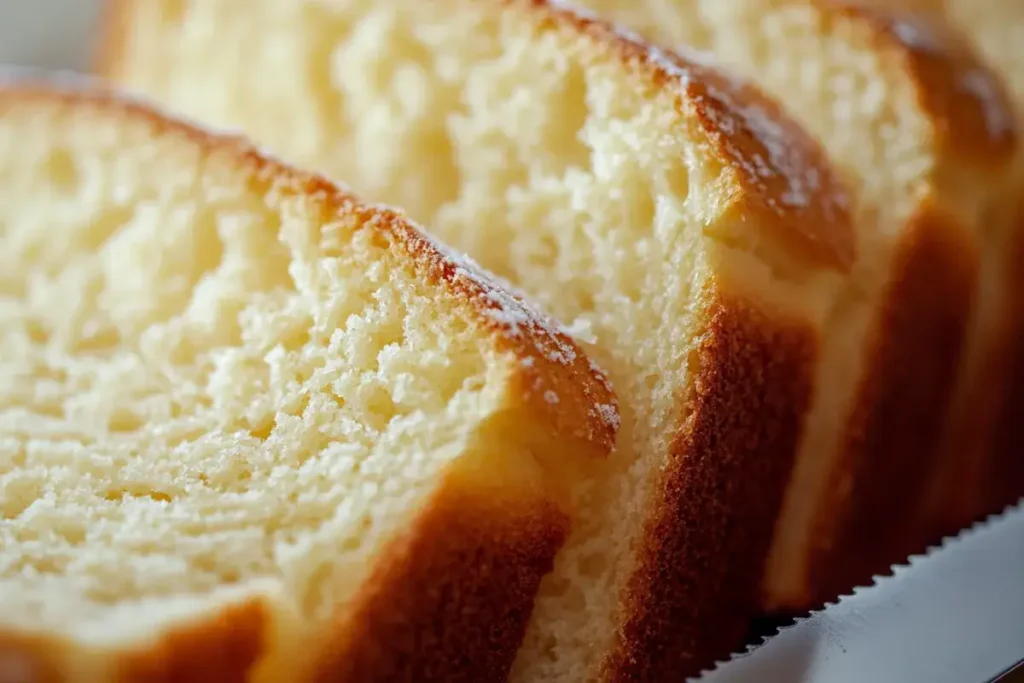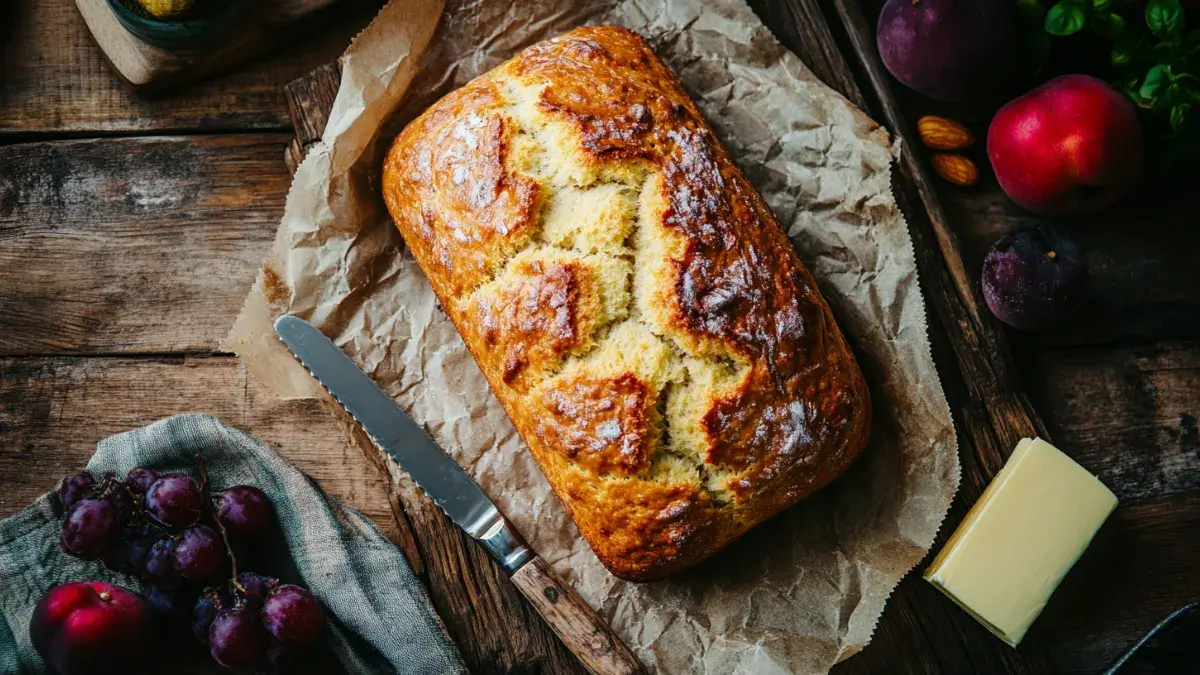Introduction
If you’re looking for a delightful, versatile baked good that can be enjoyed at any time of the day, then you’re in the right place. Sweet bread is one of those easy-to-make, crowd-pleasing recipes that’s perfect for breakfast, brunch, or a quick snack. The best part? It doubles as a wonderful gift for holidays or special occasions.
This sweet bread recipe is my go-to for its simplicity and ability to pair well with so many flavors. To ensure perfect results, it’s important to start by measuring flour properly, as this can greatly impact the texture of your bread. Whether you’re adding a glaze, mixing in fruits, or serving it plain, the result is always a delicious, moist loaf that’s both tender and slightly sweet. If you’re curious about the science behind the ingredients, understanding the difference between baking powder and baking soda can help improve your baking technique. It’s a quick bread recipe, which means there’s no need for yeast, making it easy to whip up in no time. From personal experience, this recipe has become a staple in my home for its versatility and sheer ease.
Not only is this bread delicious on its own, but it’s also a great base for experimentation. You can add in different mix-ins like nuts, chocolate, or fruits to customize it to your liking. Trust me, once you try this sweet bread recipe, you’ll be making it on repeat for all occasions.
Basic Sweet Bread Recipe
Ingredients:
- 2 cups white granulated sugar
- 4 cups all-purpose flour
- 2 tablespoons baking powder
- 1 teaspoon salt
- 2 large eggs
- 2 cups milk
- ⅔ cup vegetable oil
Step-by-Step Instructions:
- Preheat the oven to 350°F (175°C). Grease 6 miniature loaf pans or 2 large loaf pans to prepare for baking.
- Combine dry ingredients: In a medium mixing bowl, whisk together the sugar, flour, baking powder, and salt. Set this mixture aside.
- Mix wet ingredients: In a separate large mixing bowl, whisk the eggs, milk, and vegetable oil together until just combined.
- Combine wet and dry ingredients: Slowly add the dry ingredients to the wet ingredients, stirring gently with a spatula or a mixer on low speed. Mix until the batter is just combined, avoiding overmixing.
- Pour the batter into the prepared loaf pans, filling each pan about ¾ full to leave room for the bread to rise. For a beautiful finish, you can sprinkle a little sugar on top of each loaf before baking.
- Bake for 40–50 minutes if using miniature loaf pans, or up to 60 minutes for larger loaves. To check if the bread is done, insert a toothpick into the center of the loaf—if it comes out clean, your bread is ready!
- Let it cool in the pan for 10 minutes before transferring to a wire rack to cool completely.
Optional Toppings:
- Sugar for a sparkling finish before baking.
- Citrus Glaze: Mix powdered sugar and lemon or orange juice for a quick glaze to drizzle on top once the bread has cooled.
This basic sweet bread recipe yields moist and tender loaves that are perfect for sharing. I personally love gifting miniature loaves during the holidays!

Baking Tips for Perfect Sweet Bread
Tips from My Test Kitchen:
- Measuring flour accurately: Always spoon flour into your measuring cup and level it off with a flat edge. This prevents you from packing too much flour into the cup, which can make the bread dense and dry.
- Don’t overmix: Once you’ve combined the dry and wet ingredients, be gentle. Overmixing can lead to tough, dense bread. Stir just until the ingredients are incorporated to keep the bread light and fluffy.
- Adapt to your baking vessel: The size, material, and even color of your baking pans can affect the outcome. For example, darker pans may bake faster. Be sure to keep an eye on your loaves, especially the first time you try a new pan.
Common Mistakes and How to Avoid Them:
- Overfilling pans: Always leave room for the bread to rise. Filling pans more than ¾ full can cause the batter to overflow, leading to a mess and unevenly baked loaves.
- Incorrect oven temperature: Using an oven thermometer can be helpful to ensure your oven is at the right temperature. Too hot, and the bread will brown too quickly without baking through. Too cool, and it won’t rise properly.
By following these simple tips, you can avoid common mistakes and ensure your sweet bread recipe turns out perfectly every time.
Sweet Bread Recipe Variations
One of the best things about this sweet bread recipe is its versatility. With a simple base, you can easily customize the flavor by adding different mix-ins and flavor substitutions. Let’s dive into some delicious ways to enhance your sweet bread and make it your own!
Adding Mix-ins
Mix-ins are a fantastic way to add texture and bursts of flavor to your sweet bread recipe. Here are a few of my favorites:
- Fruits: Adding fresh or dried fruits can bring a delightful sweetness and tanginess to the bread. You can fold in up to 1 cup of any of the following fruits:
- Apples: Diced apples add a juicy texture and a lovely sweetness, especially when paired with a cinnamon swirl.
- Cranberries: Perfect for holiday baking, cranberries bring a tart punch to balance the sweetness of the bread.
- Blueberries: These tiny bursts of flavor bring a fresh, summery note to your bread.
- Nuts: For a bit of crunch, fold in up to ½ cup of your favorite nuts:
- Walnuts: These add a mild, earthy flavor that complements the sweetness of the bread.
- Pecans: Known for their buttery flavor, pecans pair beautifully with sweet bread, especially when mixed with a bit of cinnamon.
- Chocolate Chips: Who can resist the addition of chocolate? Stir in ½ cup of semisweet or dark chocolate chips for a more indulgent take on the classic sweet bread recipe.
Flavor Substitutions
If you’re looking to deepen the flavor of your sweet bread, consider swapping out some of the standard ingredients:
- Using brown sugar: If you want a richer, more caramel-like sweetness, substitute the granulated sugar with brown sugar. The molasses in brown sugar adds depth to the flavor and gives the bread a slightly denser texture.
- Using extracts: Add up to 1 tablespoon of your favorite extract to the batter for a new twist:
- Vanilla: Classic and universally loved, vanilla extract enhances the sweet, buttery flavor of the bread.
- Almond: Almond extract adds a nutty, aromatic flavor that pairs wonderfully with fruit mix-ins.
- Lemon or Orange: Citrus extracts bring a bright, fresh taste to the bread, perfect for spring or summer baking.
By experimenting with different mix-ins and flavor substitutions, such as those in this sweet potato bread recipe, you can tailor this sweet bread recipe to suit any occasion or personal preference.
Glazes and Toppings for Sweet Bread
Topping your sweet bread recipe with a glaze can take it from everyday delicious to dessert-worthy.

For more inspiration, you can try this tangy pineapple cake recipe for a unique twist on glazes. Here are a few simple glazes that can elevate your sweet bread to the next level:
Glazes
- Lemon Glaze:
- Ingredients: 1 cup powdered sugar, 2 tablespoons fresh lemon juice, 1 teaspoon lemon zest.
- Instructions: Whisk the powdered sugar, lemon juice, and zest together until smooth. Drizzle over the cooled bread for a tangy, sweet finish.
- Orange Glaze:
- Ingredients: 1 cup powdered sugar, 2 tablespoons fresh orange juice, 1 teaspoon orange zest.
- Instructions: Similar to the lemon glaze, mix the ingredients until smooth, then drizzle over the bread. The orange flavor complements any nut or fruit mix-ins.
- Apple Glaze:
- Ingredients: 1 cup powdered sugar, 2 tablespoons apple cider or juice, ½ teaspoon cinnamon.
- Instructions: Mix until smooth and drizzle over the bread. This glaze is especially delightful on a fall-flavored sweet bread with apples or cranberries.
Cream Cheese Glaze (Optional)
If you’re in the mood for something a little richer, this cream cheese glaze is a fantastic option.
- Ingredients:
- 4 oz cream cheese, softened
- 1 cup powdered sugar
- 2 tablespoons milk
- 1 teaspoon vanilla extract
- Instructions:
- In a bowl, beat the softened cream cheese until smooth.
- Gradually add the powdered sugar and milk, alternating until the glaze reaches your desired consistency.
- Stir in the vanilla extract and drizzle the glaze over the cooled bread.
This glaze pairs beautifully with any variation of sweet bread, adding a creamy, tangy contrast to the sweetness of the loaf.
Baking Alternatives
Not only can you modify the ingredients of this sweet bread recipe, but you can also play around with the baking methods and sizes to suit your needs.
Large Loaf vs. Miniature Loaf Pans
The great thing about this sweet bread recipe is that it’s flexible in terms of the baking vessel you use. Here’s how to adjust the bake time for different loaf sizes:
- Large Loaves: If you’re using a standard loaf pan (about 9×5 inches), bake the bread for 50-60 minutes. Use the toothpick test—insert a toothpick into the center of the loaf, and if it comes out clean, your bread is ready.
- Miniature Loaves: If you prefer smaller, gift-sized loaves, divide the batter into 6 miniature loaf pans. These will bake faster, usually around 40-45 minutes. The smaller loaves are perfect for gifting or portion control, and they tend to stay fresher for longer.
Making Sweet Bread Muffins
If you’re looking for a portable option or a way to serve individual portions, you can easily convert this recipe into muffins. Here’s how:
- Preheat your oven to 350°F (175°C) and grease a muffin tin or line it with paper liners.
- Prepare the batter as you would for the loaves.
- Fill each muffin cup about ⅔ full with the batter.
- Bake for 18-20 minutes, or until a toothpick inserted into the center of the muffins comes out clean.
- Let the muffins cool for 5 minutes in the pan before transferring them to a wire rack to cool completely.
These muffins are a fun way to serve sweet bread at brunches or parties, and they’re perfect for packing in lunches or enjoying as a quick snack.
By exploring these baking alternatives and variations, you can ensure that your sweet bread recipe fits any occasion, whether you’re making a large loaf for the family, miniature loaves for gifts, or muffins for an on-the-go treat.
Frequently Asked Questions (FAQs)
In this section, we’ll address some of the most commonly asked questions about sweet bread recipes. Whether you’re a beginner or an experienced baker, these answers should help you perfect your sweet bread and troubleshoot any issues that may arise.
What is sweet bread made of?
Sweet bread is typically made with a few basic ingredients that you likely already have in your pantry. The standard ingredients include:
- Sugar for sweetness.
- Flour as the base of the dough.
- Baking powder to help the bread rise.
- Salt to enhance flavors.
- Eggs to bind the ingredients together.
- Milk to add moisture and richness.
- Vegetable oil (or melted butter) to keep the bread moist.
These simple ingredients come together to create a bread that is soft, moist, and slightly sweet—perfect for breakfast or dessert.
Can I add fruits to my sweet bread recipe?
Absolutely! Adding fruits to your sweet bread recipe is one of the easiest ways to personalize it. Fresh or dried fruits work well, and you can add up to 1 cup of mix-ins. Some popular options include:
- Diced apples for a seasonal touch, especially when paired with a cinnamon swirl.
- Dried cranberries for a tart contrast to the sweetness.
- Blueberries, either fresh or frozen, which give a burst of fresh flavor.
When adding fruits, just be sure to gently fold them into the batter to avoid overmixing, which can make the bread dense.
How long does sweet bread last?
Stored correctly, sweet bread can last for several days. Here’s a general guideline for shelf life:
- At room temperature: Sweet bread will stay fresh for up to 3 days when wrapped tightly in plastic wrap or stored in an airtight container.
- In the refrigerator: It can last up to a week, though refrigerating can slightly dry out the bread. Be sure to wrap it well to preserve moisture.
Can I freeze sweet bread?
Yes! Sweet bread freezes very well, making it a great option for make-ahead baking. To freeze sweet bread:
- Let the bread cool completely after baking.
- Wrap it tightly in plastic wrap, then cover it with a layer of aluminum foil or place it in a freezer-safe bag.
- Label it with the date and freeze for up to 3 months.
When you’re ready to enjoy the bread, allow it to thaw at room temperature for a few hours or overnight in the refrigerator.
What makes bread sweet?
The sweetness in sweet bread comes primarily from the sugar in the recipe. You can adjust the sweetness to your preference by reducing or increasing the sugar. Additionally, adding mix-ins like fruits or chocolate chips can also contribute to the sweetness. Some variations of sweet bread also use flavor extracts like vanilla or almond to enhance the overall sweetness.
How do I keep sweet bread moist?
The key to moist sweet bread is in the balance of ingredients and proper storage. Here are some tips:
- Use vegetable oil or melted butter in your batter, as these fats help keep the bread moist.
- Don’t overmix the batter; mixing too much can cause the bread to become dense and dry.
- Proper storage is essential. Always wrap the bread tightly in plastic wrap or store it in an airtight container to preserve its moisture.
Additionally, if you find that your bread is drying out after a day or two, you can try adding a glaze or spreading a bit of butter on it when serving.
Storage Tips for Sweet Bread
Proper storage is essential to keeping your sweet bread fresh and moist. Depending on how quickly you plan to enjoy it, here are the best ways to store it:
At Room Temperature
For short-term storage, sweet bread can be kept at room temperature:
- Wrap the bread tightly in plastic wrap or aluminum foil.
- Store it in an airtight container to protect it from air exposure, which can dry it out.
- It will stay fresh for up to 3 days at room temperature.
In the Refrigerator
If you want to extend its shelf life a bit longer:
- Refrigerate the bread wrapped in plastic wrap or in an airtight container.
- While refrigeration can slightly dry out the bread, it will last up to 1 week.
Freezing Sweet Bread
For long-term storage, freezing is the best option:
- Let the bread cool completely.
- Wrap it in plastic wrap, then wrap it in a layer of aluminum foil or place it in a freezer-safe bag.
- Freeze for up to 3 months.
Reheating and Serving After Freezing
When you’re ready to enjoy frozen sweet bread:
- Thaw the bread at room temperature for several hours or overnight in the refrigerator.
- To reheat, you can wrap the bread in foil and place it in a 300°F (150°C) oven for 10–15 minutes, or you can heat individual slices in the microwave for 10–20 seconds.
These methods ensure that your sweet bread stays fresh and delicious, whether you’re storing it for a few days or freezing it for later enjoyment.
Conclusion
Sweet bread is not just a simple treat—it’s a versatile and easy-to-make recipe that can be customized in countless ways. Whether you’re enjoying it plain, adding fruits and nuts, or topping it with a delicious glaze, there’s no limit to how creative you can get with this basic recipe.
I encourage you to try different variations and mix-ins to make this recipe your own. Whether you’re making a large loaf to share with family or miniature loaves as gifts, this sweet bread recipe is sure to become a favorite. Don’t forget to share your creations and ideas for new twists on this classic recipe!
Happy baking!



1 thought on “Sweet Bread Recipe: A Versatile and Easy-to-Make Delight”